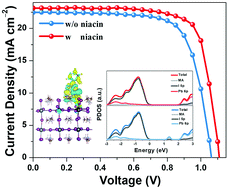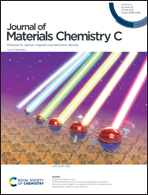Efficient defect passivation with niacin for high-performance and stable perovskite solar cells†
Abstract
Defects, inevitably produced in solution-processed halide perovskite films, can act as charge carrier recombination centers to induce severe energy loss in perovskite solar cells (PSCs). Suppressing these trap states has been regarded as one of the effective strategies to improve the photovoltaic performance and stability of PSCs. Herein, a small molecule of 3-picolinic acid, a commodity chemical with a carboxyl group (–COOH) better known by its common name niacin, which can be chemically anchored to methylammonium lead iodide (MAPbI3) through the coordination effect, is introduced to passivate the defects and control the perovskite crystal growth. Highly crystalline perovskite films with a large grain size are obtained. The passivation within the perovskite via the interaction of –COOH in niacin with Pb2+ is verified by Fourier transform infrared spectroscopy and X-ray photoelectron spectroscopy, as well as density functional theory calculations. Consequently, the device with niacin achieved a power conversion efficiency close to 20%, along with much more enhanced air and ultraviolet illumination stability, compared to the control device.



 Please wait while we load your content...
Please wait while we load your content...